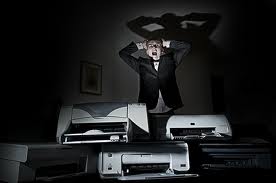HP Resource Center

Choose Your Printer
Choosing the right printer
Shopping for a printer can be overwhelming, but there are a few easy ways to narrow down your choices. Before you begin shopping, ask yourself these easy questions: "Where do I want to print? What do I need to print?" Once you've answered those questions, you're ready to dig into the details.
Laser vs. Inkjet Technologies
The first decision you need to make is whether to purchase a laser printer or an inkjet printer. Let's take a look at these two different printing technologies.
Laser
Laser printers are the most common printer found in the workplace. In general, laser printers are best at printing crisp text, legal documents and simple graphics. They are designed for higher-volume printing and have faster speeds than inkjet printers, making them a solid choice for busy offices. In addition, laser printers have a cheaper cost per page than their ink counterparts and are available in both black-and-white and color. However, laser printers are not a good choice if you need to print borderless color documents (such as 4" x 6" photos or 8.5" x 11" marketing materials), because they do not support photo paper or borderless printing.
Laser printer prices range from the low $100s for a basic black-and-white printer up to the $1,000s for a high-volume multi-user machine.
Inkjet
If you plan to print vibrant color brochures, photos and graphics, then you should definitely consider an inkjet printer. Inkjet printers produce higher-quality photo prints and color graphics compared to color laser printers. Some of the newest inkjet printers have print speeds that come close to laser printers, but keep in mind that inkjet printers are, on average, slower than laser printers. And, inkjet cartridges typically need to be replaced more frequently than laser cartridges. Inkjet printers can vary in price and range from costing less than $100 to more than $800.
Single-function vs. Multifunction/All -in -One Printers
Next, decide whether you need a single-function printer or an all-in-one. Both options are available for inkjet and laser printers. If you only need to print, then a single-function printer is the right choice for you. If you also want to scan, copy and even fax, then you're in the market for an all-in-one or multifunction printer. These all-in-one devices help reduce the clutter by eliminating the need for multiple machines. Keep in mind that not all multifunction printers have faxing capability, so if you want to fax, make sure the printer supports it. Many multifunction printers include an auto document feeder (ADF) that will allow you to stack and scan multiple sheets without the need to scan each document individually on the scanning glass. Some multifunction printers also include ports to connect your USB drive or memory card for computer-less printing.
Understanding Printer Specs and Features
Here are some of the most important specifications and features to understand when choosing your next printer.
Print Resolution
Print resolution is based upon how many dots per inch (DPI) can be printed vertically and horizontally. Generally, a higher DPI produces crisper and clearer output. Most modern printers print at least 600x600 DPI, which is acceptable for picture text and basic images. For the crispest, cleanest images, there are printers that print up to 1200x1200 DPI.
Print Speeds
Print speed is measured in pages per minute (PPM). Higher-end machines are capable of printing more than 60 pages per minute, with lower-end machines starting at 7 pages per minute in black and white. Be aware that sometimes, inkjet printer speeds are listed in draft mode, which can be misleading. Instead, look for the ISO print speed for inkjets, which is certified by the International Organization for Standardization. The ISO tests multiple printers using the same document with similar resolution, resulting in speeds that are closer to real-world print jobs.











